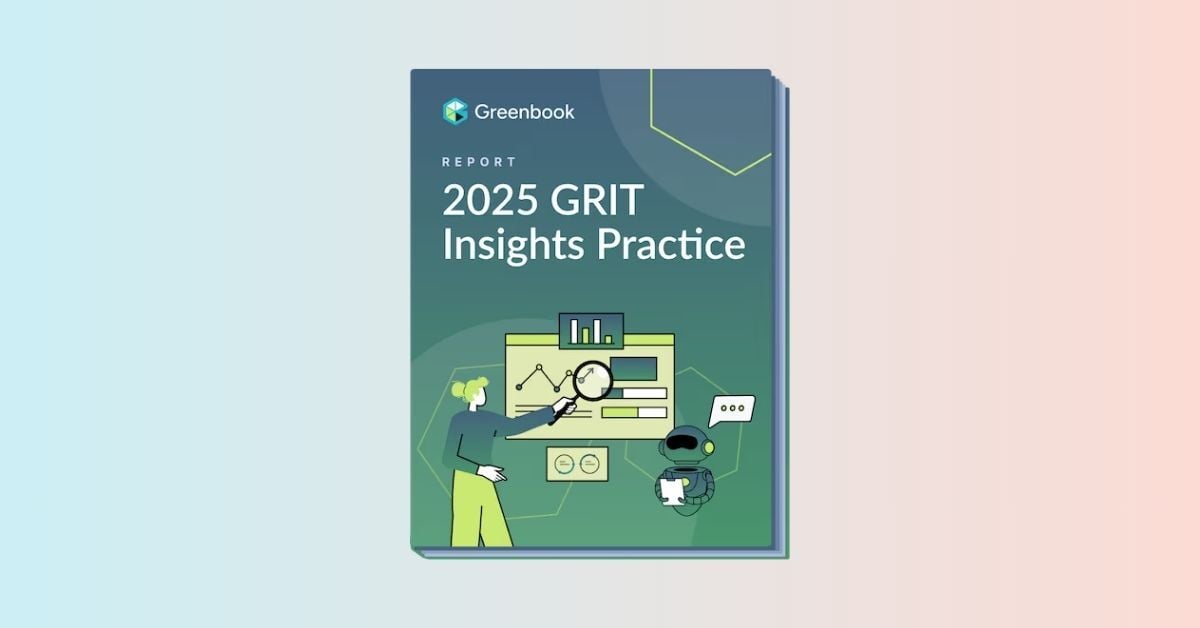
If you’re a brand-side researcher looking to level up, the 2025 GRIT Insights Practice Report offers a useful playbook. This annual report from Greenbook is based on data from insights professionals around the world, providing a glimpse into the big trends shaping our industry today.
Researchers are under pressure right now to do more, move faster, and deliver insights that drive impact. And all the tariff-related uncertainly is only escalating things. In this landscape, GRIT shows where the best research teams are leaning in, where tech is transforming the work, and where new risks are popping up.
The full report is worth perusing, but if you don’t have the time to read it, we’ve got you. Here are four key trends from GRIT 2025 that matter most for client-side researchers—and how to use them to stay ahead.
To absolutely no one’s surprise, AI is a huge topic in this year’s report. Just like what we found in our Market Research Trends 2025 survey, GRIT found that AI has moved from buzzword to baseline, and it's now embedded into many workflows.
“Generative AI has moved beyond experimentation to redefine core workflows,” said Lenny Murphy, Chief Advisor for Insights and Development at Greenbook.
From automating survey design and analyzing unstructured data to drafting full reports, AI tools is becoming part of a researcher’s day—not just something we’re testing on the side.
But this wave of innovation brings real concern: 40% of researchers still rank data quality as their top challenge. AI-generated responses and bots are part of that tension.
“Success isn’t just about having AI—it’s about knowing where to apply it,” the report’s preview notes.
33% of research buyers now value AI literacy over traditional expertise
Level up tip for insights leaders: Start using AI tools where it makes your team faster and frees up brainpower. But make sure to keep the human in the loop. AI should augment what your team does, not replace it.
Also, prioritize training. According to the report, 33% of research buyers now value AI literacy over traditional expertise, and 50% of insights professionals are reskilling for AI collaboration. If your team isn’t mastering AI, you’re at risk of falling behind.
After years of niche DIY platforms, full-service research is making a comeback—this time, powered by tech.
GRIT shows that more agencies and consultancies are managing the full research process again, from design to data to reporting. But the difference now? They’re combining their services with automation, analytics platforms, and tools for unstructured data.
That includes things like text analysis, video capture, AI tagging, and integration with big datasets. This tech + service model is helping top market research firms deliver faster, deeper insights—and hold onto clients longer.
The traditional full-service model is evolving. It’s no longer just about managing projects. It’s about delivering agile, tech-enabled insight solutions end-to-end.
Level up tips for insights leaders: If your internal team is lean, a tech-savvy partner can take on heavy lifting and deliver results faster. When choosing a market research partner, ask about their tech stack: Can do they both quant and qual? What tools do they use to ensure high engagement and better quality data? What’s automated and how are they using AI?
Whether you're working with a customer success team or a full-service firm like Reach3 Insights, the ideal partner should bring industry expertise and tech know-how to boost speed, quality and impact.
Talent cuts are still hitting many supplier-side firms in 2025. Budget pressure is real—and even after post-pandemic rehiring, layoffs and freezes are continuing. Research from the Insights Career Network, unfortunately, confirms that many people in our industry are struggling to find their next opportunity.
But the GRIT report points out an interesting trend: the bleeding is slowing for firms that have invested in research tech.
Firms with automation and analytics baked in are more stable, and in some cases, bouncing back faster. Those that rely on manual processes are still struggling.
GRIT points out that tech-enabled suppliers are showing more resilience in this environment. And that’s not just about cost savings—it’s about how teams can operate more effectively with fewer people.
Level up tip for insights teams: If your insights team is facing budget freezes or hiring slowdowns, automation can help stretch your resources. Use market research platforms that make the end-to-end research process more seamless. That frees up your team to focus on the work that really drives value—like storytelling and connecting insights to business strategy.
Data quality remains the top concern in the industry.
GRIT reports that data quality concerns have increased 40% year-over-year, mainly driven by concerns over synthetic respondents and Gen Z’s survey fatigue.
Fraud is also growing concern (especially with the rise of AI bots masquerading as real people), as well as sample integrity, bot activity, disengaged respondents, and general distrust in what the data actually represents.
Data quality concerns have increased 40% year-over-year.
As a result of these factors, global sample supply hasn’t fully recovered either. Hard-to-reach audiences (like Gen Z or B2B buyers) are especially tough to source without trade-offs.
The good news: more teams are investing in things like panel vetting, attention checks, and behavioral fraud detection. But clearly, quality is still the biggest friction point in research today.
Level up tips for insights teams: Be proactive about sample quality. Ask suppliers how they screen out fraud. Lean on tools like insight communities, where you’re engaging known participants directly. You’ll reduce fraud risk and get richer, more thoughtful responses from real people.
Also, consider SMS for your survey distribution as it’s a channel that’s harder for fraudsters to game. Asking for video feedback from participants can also help you verify that people are really who they say they are.
A natural way of improving quality? By improving the participant experience (for example, by using conversational surveys). Better inputs = better insights = better business impact.
Finally, consider the idea of “thoughtfulness” when considering the quality of your data. Outside of straight up sample fraud, it’s a more in-depth way of looking at the characteristics of good quality feedback.
Commenting on the 2025 GRIT Insights Practice Report, Elaine Riddell of Oaklins DeSilva + Phillips and Gregg Archibald of G2 Advisors, note, “The industry’s future belongs to those who embrace change without sacrificing rigor, leverage AI without losing sight of ethics, and prioritize outcomes over outputs. The question isn’t whether you’ll adapt, but how fast.”
Indeed, it's a challenging time. But also an opportunity to reimagine insights. Those who can adapt fast, level up their approach and deliver with speed and accuracy are in a great spot to win.
To get your free copy of the 2025 GRIT Insights Practice Report, visit the Greenbook website.
Subscribe to our blog to receive the latest news, trends and best practices from market research experts.


No Comments Yet
Let us know what you think